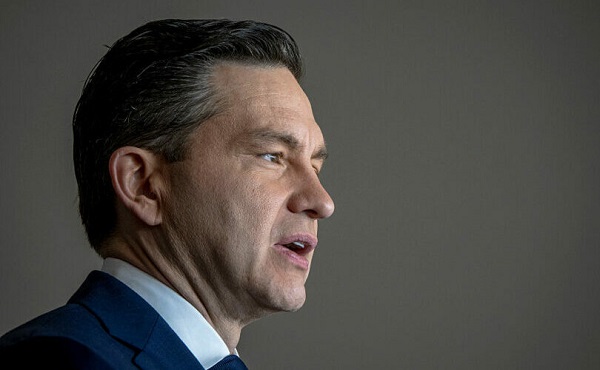Business
COVID response closed more Canadian businesses than 2008 financial crisis: gov’t report

From LifeSiteNews
StatsCan revealed that they are witnessing an increase in ‘zombie businesses,’ a phenomenon which occurs when owners never file for bankruptcy but simply walk away from their business.
Statistics Canada has revealed that more businesses closed as a result of the COVID-induced economic downturn than the 2008 financial crisis.
On October 25, Statistics Canada reported that the COVID-19 “pandemic” caused a record number of small businesses to shut down, with many owners never filing for bankruptcy but instead simply walking away from their companies, resulting in a large uptick in a phenomenon called “zombie businesses,” according to information obtained by Blacklock’s Reporter.
“This finding represents a larger increase than observed during the 2008 financial crisis when the exit rate increased by one percentage point,” wrote analysts.
The 2007- 2008 financial crisis, also called the Global Financial Crisis, is considered the most severe worldwide economic crisis since the Great Depression of 1929.
Business exits refer to the permanent closure of a business and can occur without a formal process, meaning owners can walk away from their businesses without declaring bankruptcy.
According to StatsCan, exits increased at the same time as bankruptcies fell, which is partly because courts were closed due to COVID lockdowns.
However, analysts noted that exits did not appear in bankruptcy court statistics, adding, “Formal insolvencies are not the whole story. Formal insolvency is but one path a business in distress may take.”
“The COVID-19 pandemic had a substantial impact on business dynamics leading to the temporary or permanent closure of many businesses,” analysts continued.
According to a Department of Industry estimate, Canada had 1,198,632 small businesses before COVID lockdowns. While the number has been revealed to have decreased drastically since then, federal agencies have failed to record comprehensive figures on the economic impact of COVID lockdowns and regulations.
“In my view there are hundreds of thousands of zombie businesses, businesses that are essentially dead but haven’t finalized the closure process altogether,” Dan Kelly, CEO of the Canadian Federation of Independent Business, testified at 2020 hearings of the Senate national finance committee. “We are seeing greater numbers of business failures that actually haven’t been reported. We’re only at the tip of the iceberg.”
According to a 2022 Bank of Canada survey, only an estimated half of businesses reopened after being closed by COVID lockdowns. The research tracked 12,976 businesses throughout Vancouver, Toronto and Ottawa including bars, restaurants, shops, nightclubs and motels, which were locked down by COVID regulations in April and May 2021.
“Half of businesses recorded as temporarily closed in May had reopened by the end of September,” the Bank reported. “Forty percent were still hibernating. Ten percent were closed for good.”
Statistics Canada’s report comes as Liberals MPs recently opted for a closed-door review by Minister of Health advisers of how the Canadian government handled the COVID-19 “pandemic” instead of launching a public inquiry.
In recent months, numerous reports have emerged revealing the Trudeau government’s mismanagement during the COVID-19 “pandemic.”
In a 2021 report Pandemic Preparedness, the Auditor General revealed that the cabinet was “not adequately prepared.”
Furthermore, Lessons Learned From The Public Health Agency Of Canada’s COVID-19 Response, an internal audit, condemned managers for “confusion,” “limited public health expertise” and “no clear understanding” of how to compile critical data.
Additionally, former Finance Minister Bill Morneau declared that spending programs to tackle COVID were prolonged and led to inflation under Prime Minister Justin Trudeau’s leadership.
During the so-called COVID-19 pandemic, the Trudeau government issued billions to Canadians who claimed they needed Canadian Emergency Response Benefits (CERB) as they were not permitted to work under COVID regulations.
Recently, the Canadian Revenue Agency (CRA) has worked to take back the $3.2 billion from Canadians who filed for and were given CERB despite not being eligible to receive it. However, many are fighting in court to keep their government payments.
Business
It Took Trump To Get Canada Serious About Free Trade With Itself

From the Frontier Centre for Public Policy
By Lee Harding
Trump’s protectionism has jolted Canada into finally beginning to tear down interprovincial trade barriers
The threat of Donald Trump’s tariffs and the potential collapse of North American free trade have prompted Canada to look inward. With international trade under pressure, the country is—at last—taking meaningful steps to improve trade within its borders.
Canada’s Constitution gives provinces control over many key economic levers. While Ottawa manages international trade, the provinces regulate licensing, certification and procurement rules. These fragmented regulations have long acted as internal trade barriers, forcing companies and professionals to navigate duplicate approval processes when operating across provincial lines.
These restrictions increase costs, delay projects and limit job opportunities for businesses and workers. For consumers, they mean higher prices and fewer choices. Economists estimate that these barriers hold back up to $200 billion of Canada’s economy annually, roughly eight per cent of the country’s GDP.
Ironically, it wasn’t until after Canada signed the North American Free Trade Agreement that it began to address domestic trade restrictions. In 1994, the first ministers signed the Agreement on Internal Trade (AIT), committing to equal treatment of bidders on provincial and municipal contracts. Subsequent regional agreements, such as Alberta and British Columbia’s Trade, Investment and Labour Mobility Agreement in 2007, and the New West Partnership that followed, expanded cooperation to include broader credential recognition and enforceable dispute resolution.
In 2017, the Canadian Free Trade Agreement (CFTA) replaced the AIT to streamline trade among provinces and territories. While more ambitious in scope, the CFTA’s effectiveness has been limited by a patchwork of exemptions and slow implementation.
Now, however, Trump’s protectionism has reignited momentum to fix the problem. In recent months, provincial and territorial labour market ministers met with their federal counterpart to strengthen the CFTA. Their goal: to remove longstanding barriers and unlock the full potential of Canada’s internal market.
According to a March 5 CFTA press release, five governments have agreed to eliminate 40 exemptions they previously claimed for themselves. A June 1 deadline has been set to produce an action plan for nationwide mutual recognition of professional credentials. Ministers are also working on the mutual recognition of consumer goods, excluding food, so that if a product is approved for sale in one province, it can be sold anywhere in Canada without added red tape.
Ontario Premier Doug Ford has signalled that his province won’t wait for consensus. Ontario is dropping all its CFTA exemptions, allowing medical professionals to begin practising while awaiting registration with provincial regulators.
Ontario has partnered with Nova Scotia and New Brunswick to implement mutual recognition of goods, services and registered workers. These provinces have also enabled direct-to-consumer alcohol sales, letting individuals purchase alcohol directly from producers for personal consumption.
A joint CFTA statement says other provinces intend to follow suit, except Prince Edward Island and Newfoundland and Labrador.
These developments are long overdue. Confederation happened more than 150 years ago, and prohibition ended more than a century ago, yet Canadians still face barriers when trying to buy a bottle of wine from another province or find work across a provincial line.
Perhaps now, Canada will finally become the economic union it was always meant to be. Few would thank Donald Trump, but without his tariffs, this renewed urgency to break down internal trade barriers might never have emerged.
Lee Harding is a research fellow with the Frontier Centre for Public Policy.
2025 Federal Election
Carney’s budget is worse than Trudeau’s

Liberal Leader Mark Carney is planning to borrow more money than former prime minister Justin Trudeau.
That’s an odd plan for a former banker because the federal government is already spending more on debt interest payments than it spends on health-care transfers to the provinces.
Let’s take a deeper look at Carney’s plan.
Carney says that his government would “spend less, invest more.”
At first glance, that might sound better than the previous decade of massive deficits and increasing debt, but does that sound like a real change?
Because if you open a thesaurus, you’ll find that “spend” and “invest” are synonyms, they mean the same thing.
And Carney’s platform shows it. Carney plans to increase government spending by $130 billion. He plans to increase the federal debt by $225 billion over the next four years. That’s about $100 billion more than Trudeau was planning borrow over the same period, according to the most recent Fall Economic Statement.
Carney is planning to waste $5.6 billion more on debt interest charges than Trudeau. Interest charges already cost taxpayers more than $1 billion per week.
The platform claims that Carney will run a budget surplus in 2028, but that’s nonsense. Because once you include the $48 billion of spending in Carney’s “capital” budget, the tiny surplus disappears, and taxpayers are stuck with more debt.
And that’s despite planning to take even more money from Canadians in years ahead. Carney’s platform shows that his carbon tariff, another carbon tax on Canadians, will cost taxpayers $500 million.
The bottom line is that government spending, no matter what pile it is put into, is just government spending. And when the government spends too much, that means it must borrow more money, and taxpayers have to pay the interest payments on that irresponsible borrowing.
Canadians don’t even believe that Carney can follow through on his watered-down plan. A majority of Canadians are skeptical that Carney will balance the operational budget in three years, according to Leger polling.
All Carney’s plan means for Canadians is more borrowing and higher debt. And taxpayers can’t afford anymore debt.
When the Liberals were first elected the debt was $616 billion. It’s projected to reach almost $1.3 trillion by the end of the year, that means the debt has more than doubled in the last decade.
Every single Canadian’s individual share of the federal debt averages about $30,000.
Interest charges on the debt are costing taxpayers $53.7 billion this year. That’s more than the government takes in GST from Canadians. That means every time you go to the grocery store, fill up your car with gas, or buy almost anything else, all that federal sales tax you pay isn’t being used for anything but paying for the government’s poor financial decisions.
Creative accounting is not the solution to get the government’s fiscal house in order. It’s spending cuts. And Carney even says this.
“The federal government has been spending too much,” said Carney. He then went on to acknowledge the huge spending growth of the government over the last decade and the ballooning of the federal bureaucracy. A serious plan to balance the budget and pay down debt includes cutting spending and slashing bureaucracy.
But the Conservatives aren’t off the hook here either. Conservative Leader Pierre Poilievre has said that he will balance the budget “as soon as possible,” but hasn’t told taxpayers when that is.
More debt today means higher taxes tomorrow. That’s because every dollar borrowed by the federal government must be paid back plus interest. Any party that says it wants to make life more affordable also needs a plan to start paying back the debt.
Taxpayers need a government that will commit to balancing the budget for real and start paying back debt, not one that is continuing to pile on debt and waste billions on interest charges.
-

 2025 Federal Election2 days ago
2025 Federal Election2 days agoPolls say Canadians will give Trump what he wants, a Carney victory.
-

 2025 Federal Election2 days ago
2025 Federal Election2 days agoThe Anhui Convergence: Chinese United Front Network Surfaces in Australian and Canadian Elections
-

 2025 Federal Election2 days ago
2025 Federal Election2 days agoTrump Has Driven Canadians Crazy. This Is How Crazy.
-

 2025 Federal Election2 days ago
2025 Federal Election2 days agoCarney Liberals pledge to follow ‘gender-based goals analysis’ in all government policy
-

 2025 Federal Election2 days ago
2025 Federal Election2 days agoPoilievre’s Conservatives promise to repeal policy allowing male criminals in female jails
-

 conflict2 days ago
conflict2 days agoTrump tells Zelensky: Accept peace or risk ‘losing the whole country’
-

 2025 Federal Election1 day ago
2025 Federal Election1 day agoPoilievre Campaigning To Build A Canadian Economic Fortress
-

 Automotive1 day ago
Automotive1 day agoCanadians’ Interest in Buying an EV Falls for Third Year in a Row






